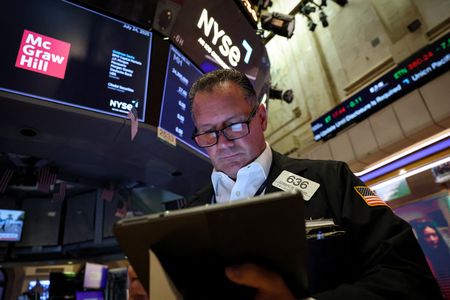By Jamie McGeever
ORLANDO, Florida (Reuters) -TRADING DAY
Making sense of the forces driving global markets
By Jamie McGeever, Markets Columnist
Key U.S. and global stock markets clocked fresh highs on Thursday as Alphabet’s earnings lifted tech, while investors digested the European Central Bank’s interest rate decision and the latest signals from the European Union on trade talks with the U.S.
More on that below. In my column today I ask if the stock market euphoria around the incoming U.S. trade deals is warranted. Remember, tariffs will be the highest since the 1930s and are set to raise inflation and lower growth.
If you have more time to read, here are a few articles I recommend to help you make sense of what happened in markets today.
1. ECB keeps rates steady as it awaits clarity over trade 2. Big central bank rate cuts slow with tariffs andpolitics in headlights 3. Conditions as loose as 2021 call into question more Fedcuts: Mike Dolan 4. Meme stock surge underlines market froth, mostlycentered on retail investors 5. In earnings season, it’s AI good, everything else, notso much
Today’s Key Market Moves
* S&P 500, Nasdaq, FTSE 100 and MSCI All Country all hit newhighs again. * But the Dow and Russell 2000, less tethered to the AIfrenzy, fall 0.7% and 1.4%, respectively. * Some big U.S. names post big share price declines on Q2earnings: Tesla -9%, IBM -8%, Honeywell -5%. * Oil snaps a four-day losing streak to rise over 1%. * China’s yuan hits its strongest level this year againstthe U.S. dollar, both onshore and offshore.
AI drives new highs
In the absence of major economic data surprises, monetary policy changes or trade deal news on Thursday, world markets took their cue from corporate earnings, which continue to point to strength in artificial intelligence-related activity.
Google’s parent company Alphabet grabbed the spotlight, its second-quarter results highlighting that the heavy investment in AI is paying off.
Indeed, a trend may be emerging from the earnings season that shows businesses focused on AI are massively outperforming companies like airlines, restaurants and food manufacturers that cater more to actual people. This isn’t just a U.S. thing, it’s global.
Of course, this isn’t a blanket rule but it will be worth keeping an eye on as the earnings season progresses. So far at least, investors are accentuating the positive and major indices are making new highs on a near daily basis.
On the policy front, the ECB kept its deposit rate on hold at 2.0% as expected, biding its time while Brussels and Washington try to negotiate a trade deal that could ease tariff uncertainty.
It appears that the bar to resume the easing cycle in September is a high one, and the euro closed the day little-changed around $1.1765.
The U.S. economic data on Thursday were relatively upbeat, showing an acceleration in service sector activity and the lowest jobless claims figures in three months. With numbers like that, the S&P 500 at a record high and wider financial conditions loose, the Fed may not be in such a hurry to cut rates.
And on that score, investors will be paying close attention to the readout from U.S. President Donald Trump’s visit to the Fed late on Thursday.
Fed Chair Jerome Powell is expected to be present during the visit. It will be an awkward meeting – Trump has repeatedly demanded that the Fed slash interest rates and has frequently raised the possibility of firing him. On Tuesday, he called Powell a “numbskull.”
Markets’ trade deal euphoria ignores tariff reality
The optimism sweeping world stock markets following news of emerging and expected U.S. trade deals is undeniable and understandable. But it is also puzzling.
The S&P 500, Britain’s FTSE 100 and the MSCI All Country index have powered to new highs this week, and other global benchmarks are not far behind. Analysts at Goldman Sachs and other big banks have recently been raising their year-end S&P 500 forecasts by as much as 10%.
The catalyst is clear: baseline tariffs on imported goods into the U.S. will be much lower than the duties President Donald Trump had threatened previously. It emerged this week that the levy on Japanese goods will be 15%, not 25%, and indications are that a deal with the European Union will land on 15% too. That’s half the rate Trump had threatened to impose.
Suddenly, the picture is nowhere near as bleak as it looked a few months ago. Economists reckon that the final aggregate U.S. tariff rate will settle around 15-20% once deals with Brussels and Beijing are reached, a level markets are betting won’t tip the economy into recession.
This suggests that Trump’s seemingly chaotic strategy – threaten mutually assured economic destruction, extract concessions and then pull back to limit the market damage – is paying off. But will it?
SOMEONE MUST PAY
Despite the market euphoria, the fact remains that on December 31 last year, the average aggregate U.S. tariff on imported goods was around 2.5%. So even if that ends up in the anticipated 15-20% range, it will still be at least six times what it was only a few months ago, and comfortably the highest it has been since the 1930s.
U.S. Treasury Secretary Scott Bessent estimates that tariff revenues this year could reach $300 billion, which is the equivalent to around 1% of GDP. Extrapolating last year’s goods imports of $3.3 trillion to next year, a 15% levy could raise close to $500 billion, or just over 1.5% of GDP.
So who will pick up that tab? Is it the U.S. consumer, importers or the overseas exporters? Or a mixture of all three? The likelihood is it will mostly be split between U.S. consumers and companies, squeezing household spending and corporate profits. Either way, it’s hard to see how this would not be detrimental to growth.
We may not know for some time, as it will take months for the affected goods to come onshore and get onto U.S. shelves and for the tariff revenues to be collected.
“We’ve got a ways to go before we can really say the U.S. economy is feeling the full effect of the tariff policies being announced,” Bob Elliott, a former Bridgewater executive and founder of Unlimited, told CNBC on Wednesday.
But in the meantime, equity investors appear to be ignoring all of this.
SIGNS OF FROTH
The market’s short-term momentum is clear. The S&P 500 has closed above its 200-day moving average for 62 days in a row, the longest streak since 1997, according to Carson Group’s Ryan Detrick. And the ‘meme stock’ craze is back too, another sign that risk appetite may be decoupling from fundamentals.
Indeed, markets are priced for something approaching perfection. The consensus S&P 500 earnings growth for next year is 14%, according to LSEG I/B/E/S, barely changed from 14.5% on April 1, just before Trump’s “Liberation Day” tariff salvo. Even the 2025 consensus of around 9% isn’t that much lower than 10.5% on April 1.
A Reuters poll late last year showed a 2025 year-end consensus estimate for the S&P 500 of 6,500. The index is nearly there already, and is trading at roughly the same multiple as it was on December 31, a 12-month forward price-to-earnings ratio of 22.
Can these lofty expectations be supported by an economy whose growth rate next year is expected to be 2% or less? Possibly. But it will be a challenge for most firms, with the exception of the ‘Magnificent Seven’ tech giants whose size might better shield them from tariffs or slowing growth.
Ultimately, this is all a huge experiment pitting protectionist trade policy and Depression-era tariffs against the economic orthodoxy of the past 40 years. And it’s yet another example of equity investors’ ability to find the silver lining in almost anything.
As Brian Jacobsen, chief economist at Annex Wealth Management, says: “‘It could have been worse’ is not a good foundation for a market rally”.
What could move markets tomorrow?
* Japan Tokyo CPI inflation (July) * Japan services PPI inflation (June) * UK GfK consumer confidence (July) * UK retail sales (June) * Germany Ifo business sentiment index (July) * U.S. durable goods (June) * U.S. Q2 earnings
Want to receive Trading Day in your inbox every weekday morning? Sign up for my newsletter here.
Opinions expressed are those of the author. They do not reflect the views of Reuters News, which, under the Trust Principles, is committed to integrity, independence, and freedom from bias.
(By Jamie McGeever; Editing by Nia Williams)










